The cassowary might not be a household name like the eagle or hawk, but it holds a unique and rather unsettling title: the world’s most dangerous bird. Also known as the cassowary, it is known for its sharp claws and deadly attack power. The Guinness World Records named it the "most dangerous bird in the world".While it may look striking with its vibrant colors and prehistoric features, this flightless bird has earned a reputation for being one of the most formidable animals on the planet. But what exactly makes the cassowary so dangerous, and should you really be worried about encountering one?
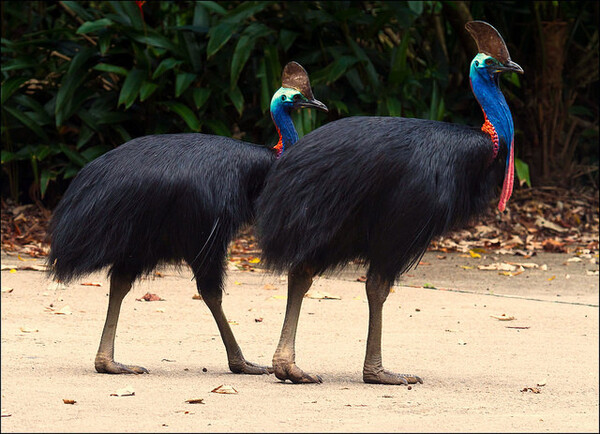
The cassowary belongs to the ratite family, which includes other flightless birds like ostriches and emus. Native to the tropical rainforests of Southeast Asia, Papua New Guinea, and Australia, there are three species of cassowaries: the southern cassowary, the northern cassowary, and the dwarf cassowary. The southern cassowary, in particular, is the largest and most well-known, often reaching heights of up to 2 meters (6 ft 6 in) and weighing as much as 60 kg (132 lb).
Cassowaries are striking to look at, with bright blue faces, glossy black feathers, and a helmet-like structure on their heads called a casque. This hard, horn-like formation serves multiple purposes, from pushing through dense forest undergrowth to potentially amplifying low-frequency calls. But while their vivid appearance might draw you in, it's their powerful legs and razor-sharp claws that make them dangerous.
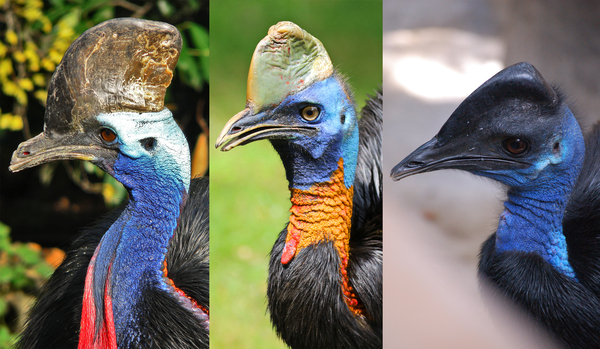
The cassowary’s status as the world’s most dangerous bird is due largely to its incredible physical abilities and natural defenses. Here’s what makes them such a force to be reckoned with:
Formidable Legs and Claws
Cassowaries have muscular legs built for power and speed. Each leg ends in three claw-tipped toes, and the inner claw is the real threat. This dagger-like claw can grow up to 12 cm (5 in) long and has been compared to a raptor’s talon. In a defensive strike, cassowaries can leap into the air and kick with these claws, inflicting deep cuts or puncturing vital organs. Such a strike can easily prove fatal to both animals and humans.
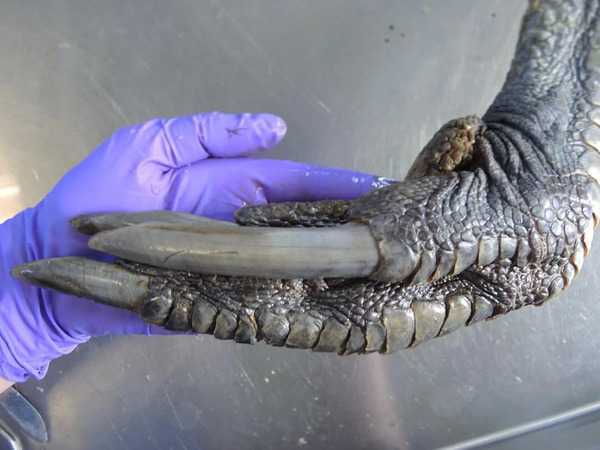
Incredible Speed and Agility
Despite their large size, cassowaries are remarkably fast. They can sprint at speeds of up to 50 km/h (31 mph) through dense forest terrain. Their powerful legs also allow them to leap up to 1.5 meters (5 feet) into the air, making them a fast-moving and unpredictable threat if they feel cornered or threatened.
Natural Aggressiveness
Although cassowaries are generally shy and prefer to avoid humans, they can become highly aggressive if provoked, especially if they feel threatened or are protecting their young. This is when their defensive abilities come into play, and they are known to use their powerful legs to strike attackers.
Contagious Confidence
Cassowaries don’t back down easily. Their aggressive displays can include fluffing up their feathers, hissing, and stomping the ground as a warning. If these warning signs are ignored, they are more than willing to attack to defend themselves or their offspring.
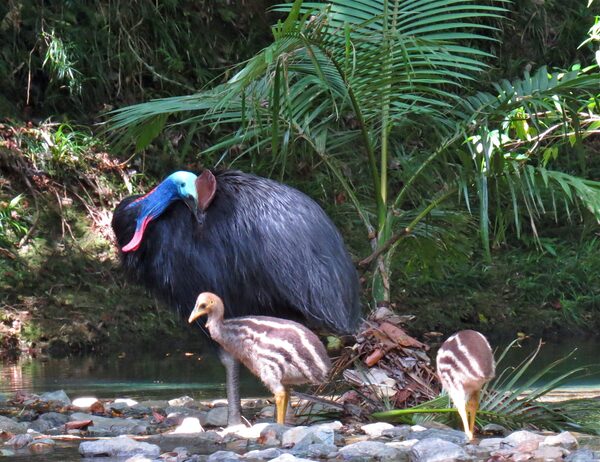
While cassowaries are undeniably equipped to kill, attacks on humans are extremely rare. However, there have been documented fatalities and serious injuries. One of the most infamous incidents occurred in 1926 when a young boy in Australia was killed by a cassowary after he tripped and fell while fleeing from it. The bird struck him in the neck with its claw, delivering a fatal blow.
More recently, in 2019, a cassowary kept in captivity in Florida fatally attacked its owner, further solidifying its fearsome reputation. Still, such occurrences are rare, and cassowaries do not go out of their way to attack humans. Most attacks happen when people get too close, often trying to feed or provoke the bird.
Cassowaries, like most animals, do not attack without reason. They are typically solitary creatures that prefer to avoid conflict. However, there are specific scenarios that can trigger aggressive behavior:
Protecting Chicks: Adult cassowaries are highly protective of their young. If they perceive any threat to their chicks, they will not hesitate to defend them, sometimes preemptively attacking anything that gets too close.
Feeling Cornered: Cassowaries thrive in dense forests where they can move quickly and hide. If they are cornered or feel trapped, they may lash out aggressively as a defense mechanism.
Human Interference: One of the growing problems is the human impact on cassowary habitats. As their rainforest homes are encroached upon by development, roads, and tourism, cassowaries are more frequently encountering people. Feeding cassowaries or leaving food out can encourage them to approach humans, leading to dangerous situations.
While cassowaries are fearsome, there are simple ways to avoid trouble if you encounter one. Environmental organizations have provided the following tips:
Don’t Feed Cassowaries: Feeding these birds encourages them to associate humans with food, increasing the likelihood of aggressive behavior when they expect to be fed.
Keep Your Distance: Always stay far away from cassowaries, especially if you see a parent bird with chicks. If a cassowary starts showing signs of aggression (hissing, puffing up), back away slowly.
Stay Calm and Don’t Run: If you find yourself near an aggressive cassowary, don’t panic or run. Running could trigger a chase, and cassowaries can easily outrun humans. Instead, try to place a barrier (like a tree or large object) between yourself and the bird.
Keep Dogs Leashed: Dogs can provoke cassowaries, and many cassowary attacks are sparked by encounters with pets.
Despite their fearsome reputation, cassowaries face significant threats due to habitat loss and human encroachment. Their rainforest habitats in northern Australia and Southeast Asia are being destroyed at alarming rates for agriculture, tourism, and development. Roads and cars are another major danger, with many cassowaries being killed by vehicles each year.
Conservation efforts are underway to protect cassowaries and their habitats. Programs like Australia’s Save the Cassowary campaign aim to raise awareness of the bird’s endangered status and promote strategies for coexistence between humans and these magnificent birds.
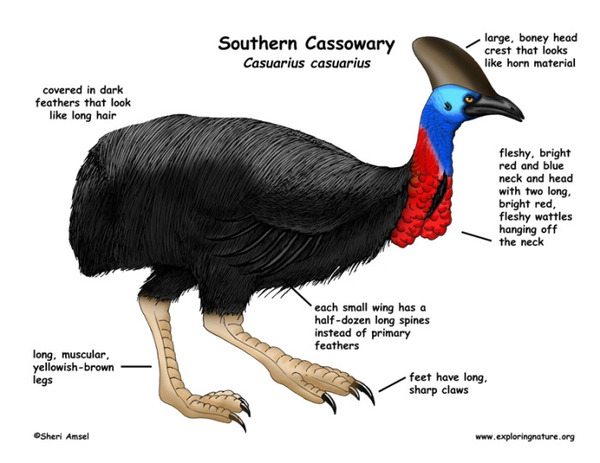
Second-Heaviest Bird: The southern cassowary is the second-heaviest bird on Earth, reaching heights of up to 5 feet 6 inches and weighing up to 157 pounds, trailing only ostriches.
Dangerous Feet: Known for their powerful kicks, cassowaries possess a 5-inch claw on their middle toe, capable of inflicting serious injuries and even breaking bones.
Fatherly Responsibilities: After mating, female cassowaries lay eggs and abandon them. Males take on the task of incubating and raising the chicks for up to nine months.
Impressive Jumpers: Cassowaries can leap up to 7 feet high and run at speeds of 30 miles per hour, making them formidable creatures.
Hidden Spike: Each cassowary has a small spike on its wing, a vestige from their evolutionary ancestors, which serves no apparent purpose.
Frugivorous Diet: Cassowaries primarily eat fruits and berries, consuming up to 11 pounds a day, and they even eat their own droppings for extra nutrients.
Mysterious Casque: The casque atop a cassowary's head may help in communication or pushing through dense underbrush, and it begins to develop around the age of two.
Long Lifespan: While wild cassowary lifespans are unknown, some have lived over 40 years in captivity, with one reported to have reached 61.
Unique Anatomy: Cassowaries have a pseudo-penis not connected to their reproductive organs, leading to fascinating cultural stories among indigenous peoples.
Rarely Fatal: Although there have been only two confirmed human fatalities attributed to cassowaries, interactions with these birds can be dangerous, especially when humans feed them and lose their natural fear.
The cassowary has rightfully earned its title as the world’s most dangerous bird, but it is also a creature worthy of respect and protection. While they possess the physical power to cause serious harm, cassowaries are not inherently aggressive towards humans. Their dangerous reputation comes from their natural defenses, designed to protect them in the wild.
As human activity continues to encroach on cassowary habitats, it’s crucial to respect these birds and give them the space they need to thrive. Admire them from afar, and if you’re ever lucky enough to spot one in the wild, remember: it’s better to let the world’s most dangerous bird strut its stuff at a safe distance.
animal tags: Cassowary
We created this article in conjunction with AI technology, then made sure it was fact-checked and edited by a Animals Top editor.